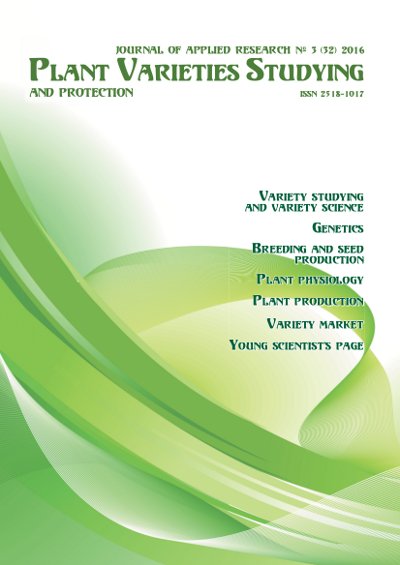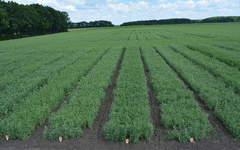Resistance of apple-tree varieties on dwarf rootstock and inserts under heat shock conditions
DOI:
https://doi.org/10.21498/2518-1017.3(32).2016.75979Keywords:
apple tree, variety, dwarf rootstock, intercalary insert, heat shock, heat toleranceAbstract
Purpose.To study the parameters of water regime in apple-tree varieties grown on dwarf rootstock 62-396 and inserts 62-396 and 3-17-38 during the vegetation period in relation to their heat tolerance.
Methods.Field investigations, statistical evaluation, analytical approach.
Results.A high level of water content ranging from 71.5 to 73.1% was determined in the leaves of apple-tree varieties at the beginning of vegetation.An average level of water content (from 62.8 to 65.5%) in leaves of studied apple-tree scion-rootstock combinations was recorded during the period of the intensive growth of shoots and formation of ovaries and fruits (June–August). There was no significant difference between varieties as for water content in leaves. Analysis of variance revealed the significant reliable difference as for water content in leaves between dwarf rootstock and inserts at p < 0.05. It was determined that on average for the period of two years ‘Yablochny Spas’ variety lost less water than ‘Orlinka’ after the heat shock. At the same time, the maximum water-holding ability was revealed in the varieties on the dwarf rootstock 62-396.
Conclusions. During analysis of variance, the substantial reliable intervarietal differences were recorded for the water content at 5% and 1%-level of significance.The mutual influence between varieties, dwarf rootstock and inserts for water loss after the heat shock at p < 0.05 and 0.01 was reliably confirmed. After the impact of high temperature stress (+50 °C) and water saturation, the studied apple-tree scion-rootstock combinations were able to restore water content at a high level. Scion-rootstock combinations ‘Yablochny Spas’ and ‘Orlinka’ on the dwarf rootstock 62-396 were specified as those that had the highest heat tolerance potential.
Downloads
References
Yushkov, A. N., Chivilev, V. V., Borzykh, N. V., Abyzov, V. V., & Khozhainov, A. V. (2012). Resistance of fruit and berry plants to dehydration and overheating. In Adaptivnyy potentsial i kachestvo produktsii sortov i sorto-podvoynykh kombinatsiy plodovykh kul’tur: mater. Mezhdunar. nauch.-prakt. konf. [Adaptive potential and quality of products of fruit cultivars and cultivar-rootstock combinations: Proc. Int. Scientific and Practical Conf.]. (рр. 287–291). July 24–27, 2012, Orel, Russia: VNIISPK. [in Russian]
Al’tergot, V. F., Mordkovich, S. S., & Ignat’ev, L. A. (1976). Principles of estimating drought and heat resistance of plants. In G. V. Udovenko (Ed.) Metody otsenki ustoychivosti rasteniy k neblagopriyatnym usloviyam sredy [Methods of estimating plant resistance to the unfavorable environment]. (pp. 6–17). Leningrad: Kolos. [in Russian]
Chentzova, E. S. (2008). Perspektivy introduktsii i ispol’zovaniya nekotorykh vidov i klonov khurmy v Prikubanskoy zone plodovodstva [Prospects of introduction and use of some persimmon species and clones in the Kuban fruit-production zone] (Extended Abstract of Cand. Biol. Sci. Diss.). Kuban State Agrarian University, Krasnodar, Russia. [in Russian]
Chivilev, V. V., & Kirillov, R. E. (2008). Pear resistance to high temperature stresses. In Problemy agroekologii I adaptivnost’ sortov v sovremennom sadovodstve Rossii: mater. Vseross. nauch.-metod. konf. [Problems of agroecology and cultivar adaptivity in modern horticulture of Russia: Proc. All-Russian Research and Methodology Conf.]. (рр. 284–286). July 1–4, 2008, Orel, Russia: VNIISPK. [in Russian]
Ozherelieva, Z. E. Krasova, N. G., & Galasheva, A. M. (2013). Study of water regime of apple tree varieties in summer in relation to their drought and heat resistance. Dostizhenie nauki i tekhniki APK [Achievements of science and technology of AIC], 1, 17–19. [in Russian]
Ozherelieva, Z. E., Krasova, N. G., & Galasheva, A. M. (2013). Influence of dehydration and heat shock on the water regime of apple tree varieties. Nauchnoe obozrenie [Scientific review], 1, 10–13. [in Russian]
Ozherelieva, Z. E., Kurashev, O. V., Panfilova, O. V., Bogomolova, N. I., & Golyaeva, O. D. (2015). Realization of potential of berry crops resistance to hyperthermia. Plodovodstvo i yagodovodstvo Rossii [Pomiculture and small fruits culture in Russia], XXXXI, 261–265. [in Russian]
Leonchenko, V. G., Evseeva, R. P., Zhbanova, E. V., & Cherenkova, T. A. (2007). Predvaritel’nyy otbor perspektivnykh genotipov plodovykh rasteniy na ekologicheskuyu ustoychivost i biokhimicheskuyu tsennost plodov [Preliminary selection of promising genotypes of fruit plants for environmental resistance and biochemical value of fruits]. Michurinsk: N.p. [in Russian]
Dospekhov, B. A. (1985). Metodika polevogo opyta (s osnovami statisticheskoy obrabotki rezul’tatov issledovaniy) [Methods of field experiment (with the basics of statistical processing of research results)]. (5nd ed., rev.). Moscow: Agropromizdat. [in Russian]
Downloads
Published
How to Cite
Issue
Section
License
Copyright (c) 2016 Ukrainian Institute for Plant Variety Examination

This work is licensed under a Creative Commons Attribution-ShareAlike 4.0 International License.
Starting in 2022, the copyright to the publication remains with the authors
Our journal abides by the CREATIVE COMMONS copyright rights and permissions for open access journals.
Authors, who are published in this journal, agree to the following conditions:
- The authors reserve the right to authorship of the work and pass the first publication right of this work to the journal under the terms of a Creative Commons Attribution License, which allows others to freely distribute the published research with the obligatory reference to the authors of the original work and the first publication of the work in this journal.
- The authors have the right to conclude separate supplement agreements that relate to non-exclusive work distribution in the form in which it has been published by the journal (for example, to upload the work to the online storage of the journal or publish it as part of a monograph), provided that the reference to the first publication of the work in this journal is included.

























 Ukrainian Institute for Plant Varieties Examination
Ukrainian Institute for Plant Varieties Examination  Селекційно-генетичний інститут
Селекційно-генетичний інститут Institute of Plant Physiology and Genetics of the National Academy of Sciences of Ukraine
Institute of Plant Physiology and Genetics of the National Academy of Sciences of Ukraine
 The National Academy of Agrarian Sciences of Ukraine
The National Academy of Agrarian Sciences of Ukraine